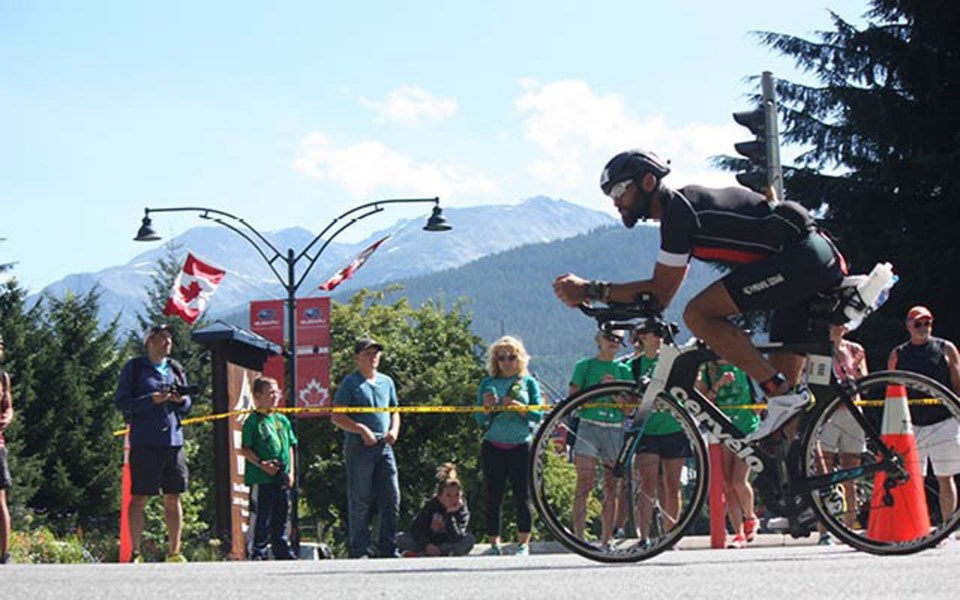In case you have been spending all your time at the lakes this week, here's a reminder that Ironman is once again set to take over our community and a good portion of the Sea to Sky Highway for most of July 29.
"Oh," I can hear you say, "That explains all the cyclists riding the highway in and around Whistler and out toward the Callaghan." Sigh.
The Resort Municipality of Whistler (RMOW) and Ironman organizers inked a new three-year deal just before last year's race. You may recall that Pemberton is no longer part of the cycling course after the village came out against the event citing safety concerns on the Pemberton Meadows Road, the low exposure the village and area gets, and the negative economic impact Ironman causes with its extensive highway and road closures.
The event will get $282,000 in Resort Municipality Initiative (RMI) funding (this is money that flows annually from the province to 14 resort destinations and must be used to grow tourism) funding a year—that's up from the previous deal of $250,000 mostly due to U.S. exchange-rate issues, said the RMOW.
There is the US$100,000 host city fee, which depends on the exchange rate on the day that the RMOW pays; US$7,500 for the volunteer director; and contributions toward the traffic management plan, traffic engineers, and race-day operations to the tune of CDN$125,000 and there are also roughly $57,000 worth of municipal services provided partially as in-kind.
But let's put aside the hard fact of the RMI funding for a moment and ask ourselves why any RMI money at all is being spent on an event that is part of a global billion-dollar industry (in the U.S., the triathlon market was estimated to be worth US$3 billion, according to a study by MultiSport Research)?
Let's consider the fact that Ironman was bought by one of China's wealthiest people, Wang Jianlin, who Forbes values at about US$30 billion — clearly a man who knows a thing or two about making money.
Dalian Wanda bought Ironman in 2015 for US$650 million and the Guardian reported that Ironman brought in more than $180 million in the year of its purchase with the event growing at more than 20 per cent a year—and remember this is an event with no permanent structures, staffed almost entirely by volunteers!
Does this sound like a company that needs RMI funds? Would RMI funds perhaps be better spent supporting more grassroots events to drive tourism here and do we even need to bring more tourists to Whistler in July?
It might also be interesting to consider if we are getting a good return on this taxpayer-funded investment? How does Ironman stack up against some other large-scale, RMI-funded events?
The World Ski and Snowboard Festival got $100,000 this year with economic activity pegged at $14.7 million (2012 stats); Crankworx received $10,000 in RMI and generated $20.2 million in economic activity in Whistler (2015 stats); Tough Mudder and Tough Mudder Half got $100,000 in RMI and brought $4.2 million to Whistler (2013 stats), and Whistler Pride and Ski Festival got $25,000 and generated $4.8 million in Whistler (2013 stats).
After last year's Ironman, a new economic study produced by the Canadian Sport Tourism Association using its Sports Tourism Economic Assessment Model found that it had an $11.5 million impact in Whistler, up from $8.4 million in 2013.
The study also found that the event drew nearly 12,000 unique attendees from 33 countries, and the average party size was 4.2 people. The average length of stay was 5.2 nights; and 27 per cent of athletes came on a separate trip to train prior to the race with an average stay of 4.2 nights.
As well, $8.8 million in visitor spending is directly attributable to the event; it provided an $8.2-million boost to the provincial gross domestic product and supported $15.6 million in economic activity across the province. Lastly, the event supported 68 Whistler-area jobs, $3.5 million in wages and salaries, and paid $3 million in taxes across the country.
These are significant impacts economically not just for us, but also for B.C. as a whole.
There is also a less tangible impact to the resort ... and it can be found amongst the throngs of cheering crowds that line the Ironman route and the scores of volunteers at aid stations—it's community pride.
Many would argue at this point in Whistler's development that a mega event like Ironman is not needed, and they may be right. But it's here until 2020—so the best thing we can do now is embrace it and make sure everyone who comes here for it has the best possible experience so they come back as tourists next time, and tell their friends all about it.




